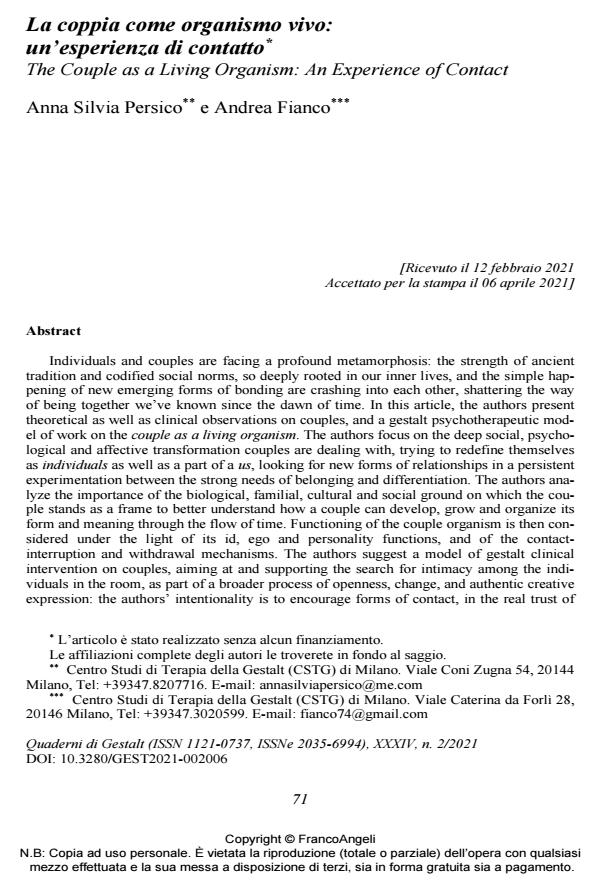The Couple as a Living Organism: An Experience of Contact
Journal title QUADERNI DI GESTALT
Author/s Anna Silvia Persico, Andrea Fianco
Publishing Year 2021 Issue 2021/2 Language Italian
Pages 16 P. 71-86 File size 218 KB
DOI 10.3280/GEST2021-002006
DOI is like a bar code for intellectual property: to have more infomation
click here
Below, you can see the article first page
If you want to buy this article in PDF format, you can do it, following the instructions to buy download credits

FrancoAngeli is member of Publishers International Linking Association, Inc (PILA), a not-for-profit association which run the CrossRef service enabling links to and from online scholarly content.
Individuals and couples are facing a profound metamorphosis: the strength of ancient tra-dition and codified social norms, so deeply rooted in our inner lives, and the simple happening of new emerging forms of bonding are crashing into each other, shattering the way of being together we’ve known since the dawn of time. In this article, the authors present theoretical as well as clinical observations on couples, and a gestalt psychotherapeutic model of work on the couple as a living organism. The authors focus on the deep social, psychological and affective transformation couples are dealing with, trying to redefine themselves as individuals as well as a part of a us, looking for new forms of relationships in a persistent experimentation between the strong needs of belonging and differentiation. The authors analyze the importance of the biological, familial, cultural and social ground on which the couple stands as a frame to better understand how a couple can develop, grow and organize its form and meaning through the flow of time. Functioning of the couple organism is then considered under the light of its id, ego and personality functions, and of the contact-interruption and withdrawal mechanisms. The authors suggest a model of gestalt clinical intervention on couples, aiming at and support-ing the search for intimacy among the individuals in the room, as part of a broader process of openness, change, and authentic creative expression: the authors’ intentionality is to encourage forms of contact, in the real trust of the beauty of the us, and in the real trust of a couple organ-ism able to self-regulate, change and grow through time in deep knowledge of each other, respect and appreciation for the vital growth of the I-Thou relationship.
Keywords: Gestalt Couple Therapy, social ground, couple organism, intimacy, I-Thou rela-tionship.
- Barthes R. (1979). Frammenti di un discorso amoroso. Torino: Einaudi.
- Bauman Z. (2006). Amore liquido. Sulla fragilità dei legami affettivi. Bari: Laterza.
- Beck U., Beck-Gernsheim E. (2008). Il normale caos dell’amore.Torino: Bollati Boringhieri.
- Benasayag M., Schmit G. (2006). L’epoca delle passioni tristi. Milano: Feltrinelli.
- Ghezzi D. (2004). Terapie con le coppie, un protocollo consolidato. Terapia Familiare, 74: 11-41.
- Bowen M. (1980). Dalla famiglia all’individuo. La differenziazione del sé nel sistema familiare. Roma: Astrolabio.
- Brazier D. (2009). Love and Its Disappointment. The Meaning of Life, Therapy and Art. Ropley. U.K.: O Books.
- Cavaleri P.A. (2007). Vivere con l’altro. Per una cultura della relazione. Roma: Città Nuova.
- Jenkins P. (2016). Gestalt Couples Therapy in the Field of Trauma, Psychology 7, 5: 695-708.
- Lee G. (2009). Il linguaggio segreto dell'intimità. Un modello gestaltico per liberare il potere nascosto nelle relazioni di coppia. Milano: FrancoAngeli.
- Melnick J., Nevis S. (1994). Intimacy and Power in Long-Term Relationships: A Gestalt Therapy-Systems Perspective. In: Wheeler G., Backman S., Eds., On Intimate Ground: A Gestalt Approach to Working with Couple . San Francisco, CA: Jossey-Bass, pp. 291-308.
- Naranjo C. (2009). Atteggiamento e prassi della terapia gestaltica. Roma: Pgreco Edizioni.
- Perls F.S., Hefferline R. Goodman P. (1997). Teoria e pratica della gestalt. Vitalità e accrescimento nella personalità umana. Roma: Astrolabio.
- Perls F. (1982). La Terapia gestaltica parola per parola. Roma: Astrolabio.
- Perls F. (1995). L’io, la fame, l’aggressività. Milano: FrancoAngeli.
- Polster E., Polster M. (1986). Terapia della Gestalt integrata. Profili di teoria e pratica. Milano: Giuffrè.
- Polster E. (1988). Ogni vita merita un romanzo. Roma: Astrolabio.
- Polster E. (2020). Enchantment and Gestalt Therapy. Partners in Exploring Life. London, UK: Routledge.
- Pizzimenti M., a cura di (2015). Aggressività e sessualità il rapporto figura/sfondo tra dolore e piacere. Milano: FrancoAngeli.
- Robine J.-M. (2006). Il rivelarsi del sé nel contatto. Studi di psicoterapia della Gestalt. Milano: FrancoAngeli.
- Spagnuolo Lobb M. (2009). Essere al confine di contatto con l’altro: la sfida di ogni coppia. In: Lee R.G., a cura di, Il linguaggio segreto dell’intimità, un modello gestaltico per liberare il potere nascosto nelle relazioni di coppia. Milano: FrancoAngeli, pp. 78-96.
- Spagnuolo Lobb M. (2011). Il now-for-next in psicoterapia. La psicoterapia della Gestalt raccontata nella società post-moderna. Milano: Franco Angeli.
- Spagnuolo Lobb M. (2012). Lo sviluppo polifonico dei domini. Verso una prospettiva evolutiva della psicoterapia della Gestalt. Quaderni di Gestalt, XXV, 2: 31-50. DOI: 10.3280/GEST2012-00200
- Spagnuolo Lobb M. (2013). Il corpo come “veicolo” del nostro essere nel mondo. L’esperienza corporea in psicoterapia della Gestalt. Quaderni di Gestalt, XXVI, 1: 41-65. DOI: 10.3280/GEST2013-001004
- Staemmler F.M. (2009). Costruzioni condivise: l’oggetto della psicoterapia della Gestalt, con specifici esempi di incomprensioni di genere sull’intimità. In: Robert G. Lee, a cura di, Il linguaggio segreto dell’intimità, un modello gestaltico per liberare il potere nascosto nelle relazioni di coppia.Milano: FrancoAngeli.
- Stevens J. (1983). Awareness: Exploring, Experimenting, Experiencing. Toronto, Canada: Bantam Books.
- Whitaker C.A. (1990). Considerazioni notturne di un terapeuta della famiglia. Roma: Astrolabio.
- Zinker J.C. (1992). The Gestalt Approach to Couple Therapy. In: Nevis E.C., a cura di, Gestalt Therapy: Perspectives and Applications. New York, NY: Gardner Press, pp. 285-304.
- Zinker J.C. (1998). In Search of Good Form: Gestalt Therapy with Couples and Families, Hillsdale, Michigan: Gestalt Press/The Analytic Press.
- Zinker J.C. (2002). Processi creativi in psicoterapia della Gestalt. Milano: FrancoAngeli.
Anna Silvia Persico, Andrea Fianco, La coppia come organismo vivo: un’esperienza di contatto in "QUADERNI DI GESTALT" 2/2021, pp 71-86, DOI: 10.3280/GEST2021-002006